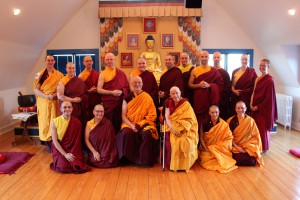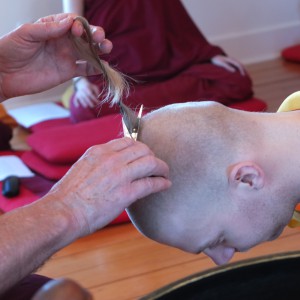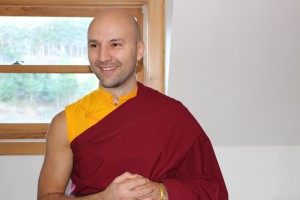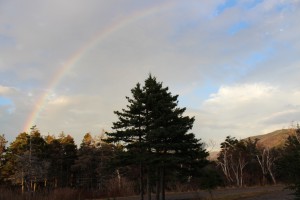Sunday
Community ArticlesOnce for a Lifetime
On Temporary Monastic Ordination
by Gelong Loden Nyima, Head of Practice and Education at Gampo Abbey
Edited by Emma Cataford, Temporary Monastic at Gampo Abbey
Photographs by Thubten Tingdzen and Adrian Thalasinos Haley
Someone once asked one of the great monastics and teachers of the Tibetan community in exile why he ordained so many tens of thousands of young monastics knowing full well that many of them would grow up in the monastery, receive an education, and then eventually give back their robes and return to the alluring household world of modern India. His answer was simple, profound, and touching. He said: “They’ll make better parents”.
In the Tibetan tradition, temporary ordination was not practiced intentionally: all monastic vows were given as life ordinations. However, in many other dharmic societies, a variety of forms of temporary ordinations have been practiced as an immersion in the dharma and a source of processing and merit for oneself and one’s society. Chögyam Trungpa Rinpoche felt that just such a temporary ordination would be of great benefit in our own society and was part of his founding intention for Gampo Abbey.
As the forces of speed, polarization, and frenetic consumption increase in our global society, so too does our need for inner strength, tranquility, and integrity. As it becomes harder to find an hour a day to meditate, it may become more helpful to take a year instead. As endless entertainment for the mind abounds, all the more precious is the opportunity to strip it away and let the mind meet itself. Ironically, the less monastic life may appear relevant to the modern world, the more relevant than ever it becomes.
“That is the method”
It is for this reason that the tradition of temporary ordination has been practiced at Gampo Abbey for over twenty years by hundreds of individuals from nearly every continent. It is for this purpose of offering places of peace in the world that monasteries continue to exist. It is for this offering to enlightened society that temporary ordination continues to be upheld in the Shambhala Monastic Order. And so, it was with great joy that ten participants from as far as New Zealand and as close as Sydney, Nova Scotia received temporary ordination on 12 December, 2014, on a sunny winter day.
This ordination not only marked the first since the establishment of the Shambhala Monastic Order, but was also the first given by preceptor Gelong Lodro Kalsang. Before giving the ordination Kalsang invoked the memories and qualities of the many Abbey monastics who have made it possible and aspired that their accomplishments continue on through us. He spoke of the monastic life being a constant practice of the paramitas, a widening of the heart which will radiate out to whatever life brings next. In this light he spoke of enlightened society being revealed within the pratimoksha, the monastic code.
The rite for ordination involves receiving and agreeing to keep the Upasaka/Upasika Bramacharya precepts (the five precepts with celibacy) and to conduct oneself as a monastic while practicing four hours a day, engaging in a course of study, and working closely with others.
The ceremony itself is simple and involves cutting one’s hair, donning robes, and adopting a Buddhist name as signals of an inner release into freedom. After aspiring to undertake the training in order to cultivate the enlightenment of all beings, a formula is repeated three times. After the final repetition the preceptor snaps their fingers and says: “That is the method,” and the newly ordained reply: “It is excellent.” And just like that the vows have been received warm hands to warm hands all the way back to the Buddha.
As Dawa Chodzo, a current temporary monk from Romania via London says, “The highlight, so far, has been our ordination day. It’s a bit hard to describe it in words. I had a sense of lightness and being uplifted. The ceremony, the community’s support, the elegant new robes, nature being part of our celebration. All these elements came together into an experience that was exhilarating and flowing for me.”
No community is an island
Society begins one mind, one conversation, one relationship, one community at a time. Tharpa Lodro, one of the new temporary monks from Washington D.C. expounds: “Being even a temporarily ordained monastic means taking the time to truly embrace the activity of enlightened society on a consistent basis. The monastic life is built for and of enlightened society and the more fully it manifests, the deeper and stronger the manifestation of enlightened society will be in this world. It also means an honored connection to a very direct lineage of blessings from the Buddha in his flesh and blood.”
In the monastery the heaven of bodhicitta and the earth of close community are joined by spending hours each day in meditation, and still more working with and surrounded by others – both “friends” and “difficult people.” It is a place whose inescapably close corners dissolve the boundary between personal practice and community life, and where the impurities of our own motivations become as obvious as burnt bits of food. Gradually, the basic goodness of ourselves and others becomes more and more obvious because there’s simply no turning away.
As Dawa said: “It feels like this is an important, precious and fortunate time in my life that the Abbey is offering support for. We’re being held in a space where discipline and decorum are emphasized. We receive subtle compassion through the teachings of Ani Pema [Chödron] and both her and the Sakyong’s direct overall involvement.”
A Process of Reflection
One may wonder what would draw someone to such an endeavor. Often our stories are as diverse as the individuals, the only universal thread being the desire to practice. Usually, this has come from a process of self-reflection and deliberate orientation in a helpful direction.
“My living in the world, engaged in a life that society approves and deems as valuable, went on with some success,” says Dawa reflecting on his decision, “yet there was also a sense of pain and dissatisfaction. I was not liking the way I was interacting with people and the world and I had a sense of creating more pain than happiness and relaxation. Or, in Buddhist terms that are becoming more familiar, I was engaging more in non-virtue than in virtue. So coming to the Abbey has been a natural transition fuelled by a desire to tame my mind in order to have less suffering, to be able to enter a role in society with a more generous intention and to hold a larger view of contributing and extending out to as many people as possible.”
With the Court on Our Heels
The ordination was given shortly after returning from a weekend of teachings from Sakyong Mipham Rinpoche. The weekend generously included an audience for the Abbey residents with the opportunity to ask the Sakyong questions about their upcoming venture.
After wondering about missing a year in the household world, Lodro expressed his concerns to the Sakyong and asked for his guidance. Lodro recalls, “The Sakyong said he was rather certain the world would be there regardless of whether I was at the Abbey or not and that it should be considered deeply how often one has the chance to take an extended period of time to deepen their engagement with meditation?” Lodro then had to contemplate his doubt and decide what would be of most benefit.
Upon pondering this, Lodro explains, “I have concluded that the world is still indeed out there and it seems as if it will continue to be so. My time here will help build the momentum in regards to the monastic path and those who support it. That truly I cannot think of what I could do right now that would be of more benefit to the world and society and it would be quite sad to miss such a blessed opportunity.”
Onward and outward
A monastery is a community that understands interdependence. It is sustained by offerings, and understands that by helping a person deepen their practice for a year and sending them out a little softer, it too is making an offering. It takes pride in being an ever-changing river of people from around the world, returning to the ocean with a slightly warmer current. A monastery does not reject the larger world; rather, it invites it in a few people at a time and tries to make a difference.
What kind of difference does it make?
“Temporary Ordination has been the best decision of my life at this point,” Lodro concludes. “It will be in my heartsblood for as long as I have a heart.”
~~
Read more about Gampo Abbey on Gampo Abbey’s Blog by clicking here.
Gelong Loden Nyima is a fully ordained monk and has been in residence at Gampo Abbey since 2009. He serves as Monastic Secretary to Sakyong Mipham Rinpoche and as Head of Education at Gampo Abbey, where he designs and leads training programs offered by the Shambhala Monastic Order. He was born in Texas and in his free time loves to meditate, study, and exercise.









Mar 13, 2015
Reply
Thank-you, Loden, for the heartfelt and personal post! I once participated in the Gampo Abbey Yarne Retreat and took temporary ordination. The experience was uplifting, and I felt very carefree and lighthearted in the breathtaking, wild winter of Cape Breton. What a precious opportunity indeed.
Mar 13, 2015
Reply
Temporary ordination is a new concept to me but makes perfect sense with the intention of sending the participants back into society a little softer, a little more radiant, a stronger sense of virtue and of what’s needed to promote enlightened society. Thanks so much for publishing this very informed essay.